Sustainability Module: Facilitator Notes
Slide 1: Sustainability Module

Say:
This module on Sustainability helps an organization maintain and sustain a process that has worked well at a unit level. This module is meant to augment the existing Spread module of the CUSP Toolkit while offering organizational strategies to sustain process changes in general. Throughout the module, best practices from the ambulatory surgery setting are highlighted.
Slide 2: Learning Objectives

Say:
In this module we will—
- Define sustainability and understand the importance of maintaining positive change.
- Understand the link between sustainability and spread.
- Learn how to create and implement a plan for sustainability. This includes identifying barriers to sustainability, developing solutions, and creating a sustainability plan.
- Establish a sustainability measurement plan in order to track progress in holding the gains from a successful improvement project.
- Learn from examples of sustainability success across multiple settings.
Slide 3: Overview

Say:
This module begins by defining sustainability and its importance in quality improvement, linking sustainability and spread, and discussing barriers and solutions to sustainability. Next, the module goes through the steps of developing, implementing, and measuring a sustainability plan, as well as highlighting examples of sustainability in different health care facilities.
Slide 4: Definition of Sustainability

Say:
What is the role of sustainability in the patient safety context and within an organization?
There are many definitions of sustainability. Most summarize that sustainability occurs when processes or improved outcomes continue to last within an organization after implementation has occurred. Sustainability focuses on integration, routinization, and continuation of a specific quality improvement process or long-term outcome. An improvement, such as implementing a safe surgery checklist, that has become part of the organizational culture and has been maintained regardless of workforce turnover, is an example of a sustained improvement.
Sustainability is also related to successful culture change within an organization—when the new way of doing something becomes the norm.
Slide 5: Importance of Sustainable Change in Continuous Improvement

Say:
Without sustainability, valuable time and resources spent investing in organizational improvement are wasted. Due to the high level of variability in health care, quality improvement must be continuously integrated into an organization’s culture to continue to provide high-quality care and reliable safe practices. Project fatigue can be prevented by sustaining and making new processes routine. When organizations control processes and monitor outcomes, they evaluate themselves and take control of their own improvement. Continued senior leader engagement will also improve as they see the return on investment and begin to routinely prioritize safety and quality improvement efforts. Lastly, sustainability establishes core values and engaged staff that will create a safety culture that lasts beyond the life of the project.
Slide 6: Sustainable Change After Project End?

Say:
This graph shows how effective processes help ensure that after the project formally ends, the desired improved performance trend continues upward. The goal of sustainability should not only be continued survival of implemented changes but also the continued effectiveness and capability to adapt to the changing health care environment, either internal or external to the organization. Therefore, the goal would be to embed safe practices within your organization rather than allow for backsliding or slippage of performance or individual behavior. Slippage can occur as a result of multiple organizational factors such as staffing conditions, administrators losing interest, or changes in organizational goals.
Do:
During the presentation, draw attention to the following points on the graph: the dotted line illustrating the project end, the upward trending line illustrating a sustained project, and the downward trending line illustrating slippage.
Ask:
Can anyone give an example of a quality improvement project you have participated in that followed either of these trend lines?
Slide 7: What Does Sustainability Mean for Your Facility?

Say:
Thinking about the definition of sustainability and how sustaining a project differs from implementing or spreading it, what does sustainability mean for your facility?
Ask:
How do you see other projects sustained in your facility?
Are values, beliefs, and practices incorporated into the mission of your organization and/or into existing processes?
What steps are taken to create a new norm of safe practices and continuous improvement?
Slide 8: Facilitators of Sustainable Change2

Say:
Multiple models describe the steps of change leading to a sustainable improvement. It is important to understand how individuals deal with change. Among the more recognized of these models is John Kotter’s 8 Steps of Change. In this model, Kotter defines eight steps to creating change, with the last two steps focusing on sustainability.
Step 1: Create a sense of urgency
If others see the need for change, they will be convinced of the importance of acting immediately.
Step 2: Build the guiding team
Assemble a group with the characteristics to lead the change effort and work together as a team.
Step 3: Develop a change vision and strategy
Create a vision to help direct the change effort and develop strategies for achieving that vision.
Step 4: Understanding and buy-in
Make sure that others understand and support the vision and the strategy.
Step 5: Empower others
Encourage risk-taking and nontraditional ideas, activities, and actions that will empower others to achieve the change.
Step 6: Short-term wins
Focus on change that is possible and easily achieved to motivate the team to build upon their efforts.
Step 7: Don’t let up – be relentless
Use the knowledge and momentum from short-term wins to align facility systems and policies with the vision and train a workforce to fulfill the vision. Develop strategies to maneuver around obstacles and barriers that may threaten the change effort.
Step 8: Create a new culture
Institutionalize the change by making it routine and a part of daily life in the facility. Provide transparency in data surrounding the change effort for continuous evaluation and modification of change.
Slide 9: Sustainability and Spread

Say:
Let’s discuss the link between sustainability and spread in continuous quality improvement. Both are necessary for successful safety culture change throughout an organization.
Sustainability should not to be confused with Spread, which is discussed in the CUSP Toolkit in greater detail.
Sustainability aims to maintain a process within an organizational culture, while Spread aims to disseminate the process to other units, facilities, or organizations.
Spread takes a successful process that originated at the unit level (for example, a CUSP project aimed at improving safety in surgery) to a broader population in the organization. Initially, the organization should adapt and spread the new process to similar patient populations, shifts, units, procedures, or diagnoses. After organizations put the new process in place, staff should review and tailor it, if necessary, to meet the needs of the new population.
Slide 10: Linking Sustainability and Spread

Say:
Although sustainability and spread aim to further quality improvement, how they are linked together in the quality improvement process can be challenging to distinguish. Does sustainability or spread occur first?
The quality improvement process moves through several stages. When first testing changes you hope will improve a safety process, you will go through multiple PDSA cycles (Plan, Do, Study, Act). Once a change results in improvement, then move to implementing that improvement. After monitoring data to assess successful implementation, begin the cycle of spread and sustainability.
A general way to view the link between sustainability and spread is that successful sustainability and spread of change is a continuous and overlapping cycle in which components of each occur simultaneously. Therefore, after testing an improvement through multiple PDSA cycles and implementation, a long-term improvement can be both spread and sustained at the same time. This is done through educating, continuously gaining buy-in from facilities or units, and continuing to maintain activity surrounding the improvement. The activities involved in sustainability and spread link together to complete the cycle of improvement.
For example, a unit or facility that customizes a successful improvement to fit its desired outcomes (i.e., spreading the improvement), will need direct care provider input & buy-in, therefore beginning the sustainability work process.
The link between spread and sustainability may look different from facility to facility, depending on size of facility, team makeup, and number of units. There may be facilities in which this link is more linear and those where it occurs interchangeably.
Slide 11: Planning for Sustainability

Say:
The following section discusses factors to consider when planning for sustainability. This includes how and why early planning with senior leaders and administration is important. This section also discusses how to identify barriers to sustainability, develop solutions, and create a sustainability plan.
Slide 12: Planning Early
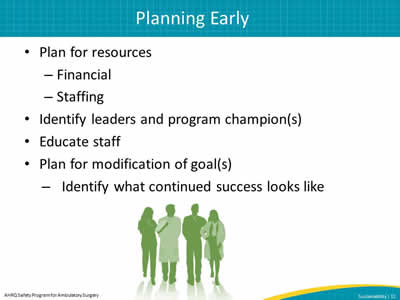
Say:
Sustainability should be considered in the beginning stages. By planning early, your facility can develop a plan that considers the resources that are needed to implement a project and how to sustain the project in case funding is discontinued or staff leave the facility, etc. Planning early helps the team think about how they will sustain their goal despite potential resource shortages in the future.
It allows your facility to identify key leaders such as program champions and supporters that will rally behind your improvement goal and create a culture of improvement.
This also allows time to create educational materials and trainings for staff to teach them how to implement and sustain improvement in addition to planning a capacity building program that works for your facility.
Most importantly, planning early for sustainability allows your facility the time to plan what continued success may look like within your facility. Continued success may be different than initial success and the team’s goal may need to be modified along the way. Therefore, planning early will help your team plan and anticipate possible modifications.
Slide 13: Potential Barriers to Sustainability
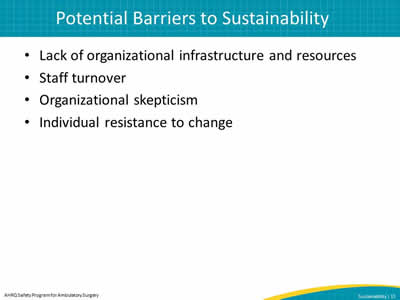
Say:
There are many reasons that programs or improvements are not sustained. Facilities should be aware of these potential barriers to sustainability:
Lack of Organizational Infrastructure and Resources
Evidence shows that programs are often discontinued when resources are reduced or no longer available. This may mean financial resources such as funding or other resources such as supplies or external organizational support. Failure to plan for resource sustainability can equal overall sustainability failure.
Staff Turnover
As people leave an organization, they take with them hours of training and knowledge about organizational processes and norms. Hiring new employees means spending time and resources training and developing skills within the organization to support improvement processes. Staff turnover can disrupt the sustainability process by depleting human resources and support in a sustainability project.
Organizational Skepticism and Resistance
Everyone responds to change differently, and some staff may not be convinced of the value of quality improvement within their facility. If staff members do not accept the change as important to them, they may prevent the team from implementing and sustaining the change within the organization.
Slide 14: Workable Solutions to Sustainability Barriers
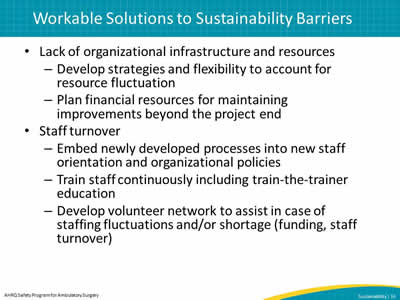
Say:
While barriers to sustainability exist, there are ways to resolve these obstacles. A few recommendations include—
- To plan for the lack of organizational infrastructure and resources, it may be necessary to develop strategies and flexibility to account for resource fluctuation. Planning for financial resources beyond the project end allows you to predict what you need for the future of the project.
- To account for the possibility of staff turnover, embed newly developed processes into new staff orientation and organizational policies. Also, plan for continuous staff training to develop capacity and skills within the organization, including train-the-trainer education. Developing volunteer networks to assist in case of human resource shortages may also be helpful.
Slide 15: Workable Solutions to Sustainability Barriers
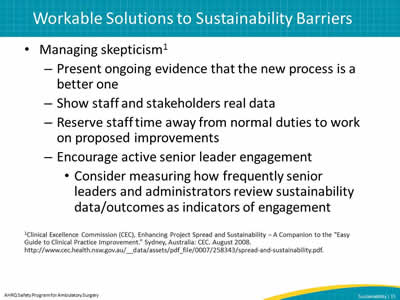
Say:
To manage skepticism, actively present ongoing evidence that the new process is a better one by showing staff and stakeholders relevant data and sharing experiences. Also, reserve staff time away from normal duties to work on proposed improvements. Encourage active senior leader engagement by measuring how frequently senior leaders and administrators review sustainability data.
Slide 16: Barrier: Individual Resistance to Change
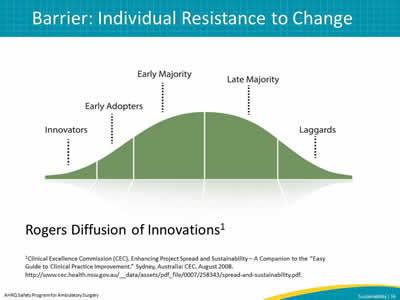
Say:
Innovations are not adopted by all staff at the same rate or at the same time. It is important to prepare for potential individual resistance among your staff and/or clinical providers.
This graph depicts Rogers’ Diffusion of Innovation Curve, which explains how individuals may react and respond to change. This model states that adoption of any new innovation or change follows a bell curve. We demonstrate these group dynamics by using an example of implementing a checklist to prevent central-line associated blood stream infections, or CLABSIs. The groups include—
Innovators, Change Agents
Innovators, or change agents, are the first group of individuals to initiate or react to change or improvements. They tend to be educated and receive information from multiple sources, and are more likely to take risks. Program champions may exist in this group due to their passion and interest in improvement innovation. They make up 2.5 percent of the population.
Example: Nurse managers, who are responsible for outcomes for their entire unit, have a vested interest in reducing harm. The role of a nurse manager is suited for an innovator; he or she not only has autonomy to institute innovations on their unit, but also has authority over the staff. Nurse managers can essentially adapt new policies and procedures such as a checklist to prevent CLABSIs. They exert a large influence on the behavior of their staff. An innovator wants to prevent events such as a patient getting a CLABSI, a “never” event, and/or the need to transfer a patient to an ICU. Nurse managers know which of their staff are the next category of Early Adopters and seek them out to help speed the rate of each innovation’s acceptance.
Early Adopters, Opinion Leaders
Early adopters, or opinion leaders, are the next group to react to change and tend to adapt earlier than most. They tend to consist of social leaders and be educated and popular. Team leaders and program champions may exist in this group due to their ability to influence and lead others. They make up 13.5 percent of the population.
Example: The role of charge nurse, which is a position situated to influence other people, is well suited for early adopters. Charge nurses are respected by their peers and generally have a reputation for the successful use of new ideas. They provide innovation advice and information sought by others in the group. They will gravitate toward a project such as using a CLABSI prevention checklist. They readily see the value in the improvement and serve as a spokesperson for the project. Early adopters tend to be patient advocates and are very passionate about patient safety.
Early Majority, Deliberators
Individuals in the early majority, or deliberators, are the first majority group to respond to change. They tend to be more deliberate in their adoption, and have many informal social contacts. They make up 34 percent of the population.
Example: The early majority will be the group that willingly follows the nurse managers and charge nurses. They will use the checklist to prevent CLABSI because they follow the leader.
Late Majority, Skeptics
Individuals in the late majority, or the skeptics, are more skeptical when it comes to change and tradition. Skeptics may need to see data for motivation and to believe that the change is worth their efforts. They make up 34 percent of the population.
Example: The late majority will only adopt use of the checklist due to strong social peer pressure. They need to see demonstration over time that the checklist is reducing CLABSIs. A way to gain buy-in from skeptics is to visually show them the number of days since the last CLABSI on their unit or for peers to pressure them to follow the new process.
Laggards, Traditionalists
Laggards, or traditionalists, are the last tier on the Innovation Curve and the least likely to take risk. Laggards may need extra coaching and motivation in order to implement and sustain an improvement process. They make up 16 percent of the population.
Example: As the nurse manager observes the team doing a new process, they can identify the team members who are not embracing the new process—they may appear suspicious of the new way of doing things, are focused on the past, and tend to interact with those around them who are like-minded. The nurse manager may need to have a one-on-one conversation with the laggard to coach or mentor the traditionalist to accept the checklist.
Recognizing the accomplishments of every individual is important, especially for those in which change is difficult (i.e., laggards and skeptics). Unique actions can be taken for each group to help sustain their gains and not backslide on improvement.
Slide 17: Factors That Influence Individual Resistance or Adoption
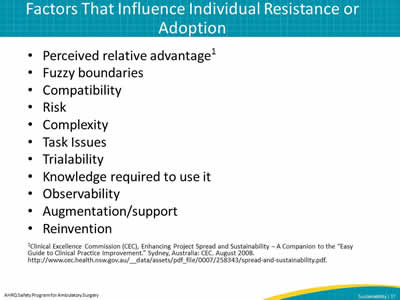
Say:
Many factors can influence adoption rates, including the following:
Relative Advantage
A clear advantage in effectiveness or cost is beneficial to adoption rates.
Fuzzy Boundaries
The adaptiveness of all of the organizational structures and systems (not just the primary unit doing the adopting) required for the full implementation of the innovation is a key attribute of the innovation.
Compatibility
Compatibility with target adopters’ values, norms, and perceived needs.
Risk
The improvement should not be perceived as being risky.
Complexity
Key players must perceive the innovation as being easy to use.
Task Issues
Tasks should be relevant to the user’s work and improve task performance.
Trialability
Users can experiment a new innovation on a limited basis.
Knowledge Required To Use It
Skills are easy to acquire and able to be transferred to other projects.
Observability
Benefits should be visible.
Augmentation/Support
Support is available.
Reinvention
Change can be modified or adapted to suit users’ needs.
Slide 18: Steps to Creating and Implementing a Sustainability Plan
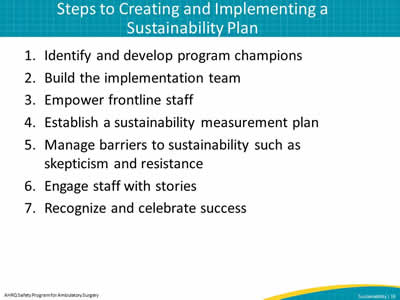
Say:
AHRQ’s Safety Program for Ambulatory Surgery has been designed to help ensure sustainability. Several critical success factors are required to sustain the interventions learned and continued gains in process and outcome improvement. They include empowering frontline staff, establishing a sustainability measurement plan, and managing skepticism and resistance.
We will begin with the first step, which is identifying and developing your program champions. Then we will discuss how to build the implementation team and empower frontline staff. Next, we will describe how to establish a sustainability measurement plan, manage barriers such as skepticism and resistance, engage staff with stories, and recognize and celebrate success.
Slide 19: 1. Identify and Develop Program Champion(s)
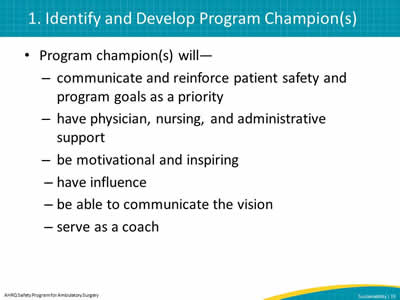
Say:
Identify and Develop Program Champion(s)
The first step in the sustainability process is to be sure to identify and partner with both administrative and clinical champions who will communicate and continually reinforce that patient safety and program goals are a priority for the organization. The team leader must have physician support, nursing support, and administrative support. Team leaders should explain the program goals and components first to these champions before rolling out to the entire team.
A champion often serves in a higher role in the organization, such as director, but can be anyone who serves as a champion for the sustained improvement. This champion may be in a different role in every facility and should be assigned at the beginning of the planning process to act as a motivator throughout the process. Ideally, a champion will have a large network with which to influence and the skills to do so.
A program champion can also be viewed as a Coach, which is described more in-depth in the Coaching Teams module of AHRQ’s CUSP Toolkit. Coaching is essential to translating knowledge into lasting behavior change, and can have a great impact on sustainability.
Slide 20: 2. Build the Implementation Team
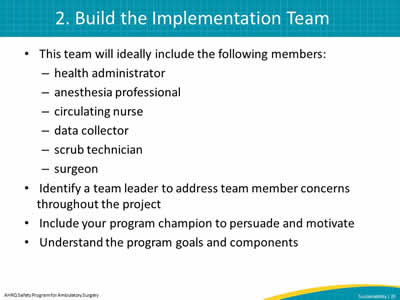
Say:
Build the Implementation Team
An implementation team will help drive the project. This team will ideally include the following team members:
- health administrator
- anesthesia professional
- circulating nurse
- data collector
- scrub technician
- surgeon
Once you have an implementation team built, identify a team leader. This individual will be responsible for addressing team member concerns throughout the project. In the example of using a checklist, the team leader will help modify the checklist and potentially help test it, attend some of the implementation team meetings and help guide the project, and talk to colleagues about using the checklist. This individual will be chosen based on their ability to influence, as well as their motivation and time commitment for the role. Team leader considerations will be discussed and decided upon within the implementation team.
The best collective decisions are made when there is diverse input. In this phase the team leader should ensure that members at all levels of the facility understand the program goals and components.
Slide 21: 3. Empower Frontline Staff
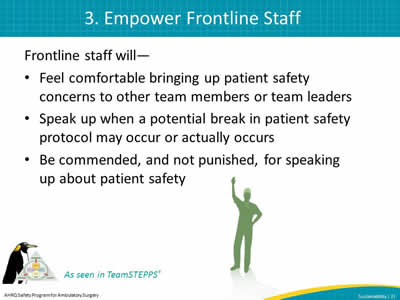
Say:
Empower Frontline Staff
Facility leads should encourage all staff to speak up when a potential break in patient safety protocol may or actually occurs. Frontline staff should be empowered and feel comfortable bringing up patient safety concerns to other team members or team leaders. Program champions play a very important role in ensuring that staff members who speak up are commended, and not punished for doing so.
Slide 22: 4. Establish a Sustainability Measurement Plan
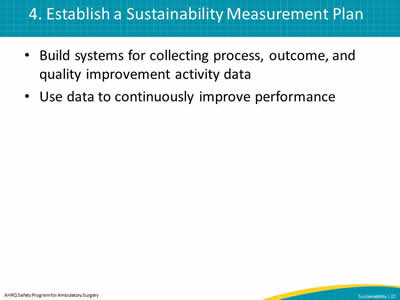
Say:
Establish a Sustainability Measurement Plan
Establishing a sustainability measurement plan is a key step in determining whether the improvement is actually being sustained. Team leaders should be coached as needed on building systems for collecting process, outcome, and quality improvement activity data, and for using those data to continuously improve performance. Establishing a sustainability measurement plan is discussed in more depth later on in this module.
Slide 23: 5. Manage Skepticism and Resistance
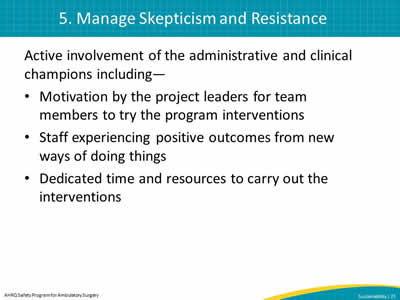
Say:
Manage Skepticism and Resistance
Active involvement of the administrative and clinical champions will assist the team lead to overcome skepticism and resistance. The team lead can also be coached to motivate team members to try the program interventions. As the staff experiences positive outcomes from new ways of doing things, these interventions will become the norm. Also, providing dedicated time and resources to carry out the interventions will go a long way to overcoming resistance.
Slide 24: 6. Engaging Staff With Stories
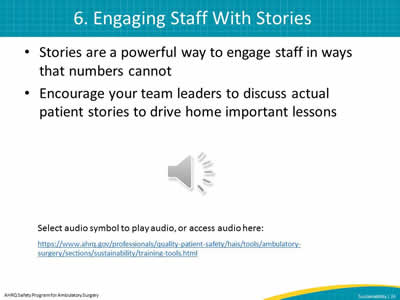
Say:
Engaging Staff With Stories
Data collection and measuring progress with rates and trend lines are important performance improvement activities. However, putting a human face on each harm event or near miss engages staff in a powerful way that numbers cannot. Encourage team leaders to discuss actual patient stories to drive home important lessons.
Note: This slide includes an audio recording. If you have trouble accessing the audio recording on this slide, it is also available on the AHRQ Web site.
The following audio recording is from Carol Culbertson, director of nursing at Audubon Surgery Center in Colorado. Carol discusses how engaging staff in stories and showing concern for your team can improve sustainability efforts by building relationships and promoting success.
Do:
Play audio. Slides must be viewed in presentation view to access the audio file.
Slide 25: 7. Recognizing and Celebrating Success
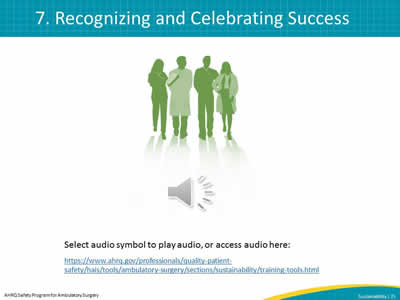
Say:
Recognizing and Celebrating Success
Recognizing success—large and small and both early on and long term—is important to sustainability. Communicating success will help frontline staff gain courage to speak up, as well as reinforce with the entire team the importance of program interventions. Celebrations need not be elaborate or formal to help sustain process and outcome gains.
Note: This slide includes an audio recording. If you have trouble accessing the audio recording on this slide, it is also available on the AHRQ Web site at: https://www.ahrq.gov/hai/tools/ambulatory-surgery/sections/sustainability.html#training.
To further illustrate the step of Recognizing and Celebrating Success, we will listen to an audio recording of Stephanie Ziesing, a registered nurse at Providence Hospital in South Carolina. Stephanie discusses how recognizing and celebrating success of her facility’s improvement (using a Safe Surgery checklist) increased buy-in from physicians and motivated the staff to sustain their gains.
Do:
Play audio. Slides must be viewed in presentation view to access the audio file.
Slide 26: Establishing a Sustainability Measurement Plan
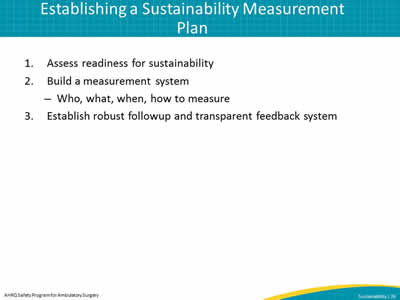
Say:
Before your facility can determine if it is holding the gains and sustaining an improvement, you must first define what sustainability means for your facility. You can then determine how to measure it and develop a sustainability measurement plan.
First, it is important to determine what “sustainability” means for your facility or for your project. Sustainability will look different in different facilities depending on resources and goals.
Next, assess the facility’s readiness for sustainability to understand the culture in the organization and determine key factors that may need strengthening in order to sustain the project.
Establishing a robust and transparent feedback system consists of—
Choosing What, When, and How To Track Process and Outcome Measures
Determining what measures you are tracking is one of the first decisions to make when establishing a measurement plan. According to what measurements are being tracked, the data may look very different from project to project. Process measures, or measures that describe how the project is implemented, will yield data for the actual intervention or improvement action. Outcomes measures, or measures that describe the effect of the intervention or improvement on the measure, will allow you to see the intervention effect within the organization. Choosing how often and how to track these measurements is very important to see improvement within the facility.
Tracking Process and Outcome Measures
Determine which measures will be collected and how your facility can gather data most efficiently. Depending on facility or team size, electronic data systems or sampling methods may be useful.
Provide feedback and progress
Provide regular feedback to senior leadership and the team on progress in reaching goals and in the rate of adoption of improvement processes across various units or facilities. This allows for data transparency throughout the facility and opportunities to troubleshoot if any issues arise or the team is behind target on goals. It is also helpful for the team to provide feedback on their experience with the project which may be used to refine the plan.
Refine Plan
Adjust the plan accordingly based on team feedback and data.
Slide 27: Assess Readiness for Sustainability
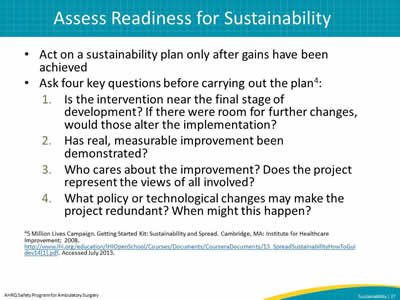
Say:
Implementation of the plan can begin after gains have been achieved.
Here are four questions that will help your facility know when to implement the plan:
- Is the intervention near the final stage of development? If there were room for further changes, would those alter the implementation?
- Has real, measurable improvement been demonstrated?
- Who cares about the improvement? Does the project represent the views of all involved?
- What policy or technological changes may make the project redundant? When might this happen?
Slide 28: Tools for Assessing Readiness for Sustainability1
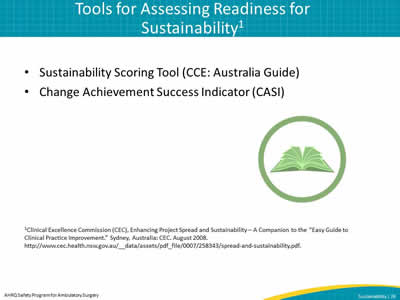
Say:
Before beginning the change process, you must first establish the safety culture of your facility and how likely it is that your change will be sustained. By doing so, you will be equipped with the knowledge of any areas that may be lacking in support or that may threaten sustainability. The following tools can assist in measuring the baseline sustainability culture at your organization and areas for improvement for successful change.
The Sustainability Scoring Tool
This tool permits the user to rate their facility on key factor areas based on the National Health Service of England (NHS) Sustainability Model. After rating each area by choosing a provided score, the scores will be totaled. A score closest to 100 indicates a higher chance of successful sustainability. A total score of 45 or less indicates reason for concern and corrective action.
The Change Achievement Success Indicator
This tool has a similar scoring method to the Sustainability Scoring Tool and is adaptable to your facility. The user gives a score between 0 and 5 to rate how many elements are met. For example, a “0” score is given when no elements are met, and a “5” score is given if all elements are met. An overall score greater than 60 indicates a likelihood that the change will be achieved, while a score below 30 indicates low chances of achievement.
Slide 29: Build a Measurement System
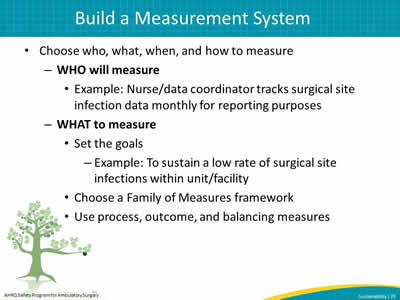
Say:
WHO will measure:
Who is responsible for tracking and managing data related to sustained processes and outcomes?
An individual or individuals must be designated for the role of collecting and reporting data. For example, using surgical site infections (SSI) as a focus area, the facility must decide who will be responsible for managing the SSI data, which they may assign to a nurse coordinator who tracks SSI data monthly. This way the facility will be aware of their SSI levels in order to see if their change is leading to a reduction in SSIs, and if the reduction is sustained. This also prevents confusion as to who should be tracking what as far as data is concerned.
WHAT to measure:
Set the Goal
Sustainable goals include those that create effective improvements that remain robust in an ever-changing health care environment and ensure continued reduction in the gaps between proven safe practices associated with positive patient outcomes. An example of a goal would be to sustain a low rate of SSIs within the unit or facility.
As you choose an area of improvement to be sustained, it is useful to choose “low hanging fruit” or a realistic goal that can be readily improved and sustained. This will aid in success while also boosting team confidence when it comes to sustaining higher improvement goals. Realize that if the change is too large in scope or difficult to sustain, it may produce project fatigue or low morale. Start small and work up to larger improvements as you modify your area of focus to what is needed and what works for your facility.
Considering the ever changing complexity of any health care or organizational system, one measure won’t provide an accurate picture of true impact of your implementation project or interventions. Using a Family of Measures framework will assist in identifying process, outcome and balancing measures.
Slide 30: Family of Measures (FOM) Example5
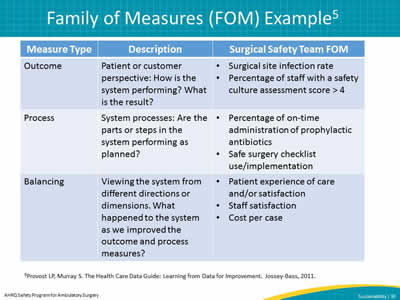
Say:
A Family of Measures Framework helps identify measures to detect any unintended consequences and avoid any process changes that could result in negative effects to the larger system. For example, a reduction in costs that increases operating room turnaround times and decreases patient satisfaction would not be desirable to sustain.
Slide 31: When To Measure
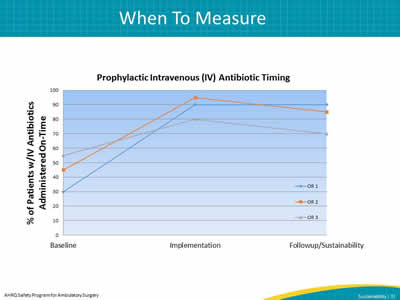
Say:
This graph shows performance results for the percentage of patients whose intravenous antibiotics were given for the prevention of surgical site infection and were administered on time. When measuring performance of a tested and implemented change, you will want to establish a baseline measurement prior to the launch of the project, measure performance during the implementation phase of the project, and during the months/years of follow-up and/or sustainability period.
The three lines represent how each of three operating rooms has performed on this measure over time. This provides an entire organizational or facility level view of how an implemented intervention to improve antibiotic timing is both spread among multiple units in a facility and shows how the intervention is being sustained in individual units and across the organization. Therefore, we again see the link between spread and sustainability in improvement efforts.
When measuring sustainability, allow enough time for performance to potentially decline before determining if the change is considered to be sustained. Internal follow-up/sustainability measurement is needed as long as the intervention or program remains useful to the facility.
Slide 32: How To Measure
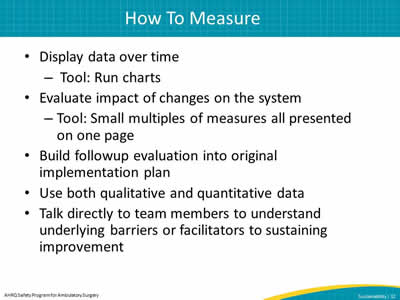
Say:
After determining who will measure, what you will measure, and when to measure, it is now time to determine how to measure. Using tools such as run charts will help your facility display data over time and track progress. Evaluating the impact of changes on the system is also important to measure. The measurement plan, including followup evaluations, should be built into the original sustainability implementation plan. Using both qualitative and quantitative data will make your measurements more robust by creating a mixed-method approach to explaining the improvement change. Talking directly to team members to understand underlying barriers or facilitators to sustaining improvement takes a qualitative approach at determining ways to make the improvement project more successful.
Slide 33: How To Measure: Run Charts5
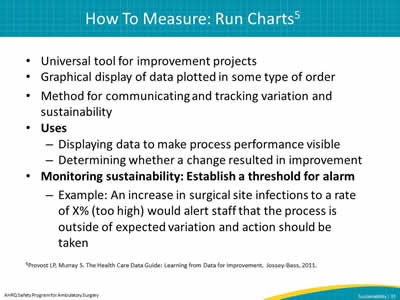
Say:
Run Charts
Run charts, also referred to as trend or time series charts, are a simple, “universal tool” that can be used for any type of improvement project. Run charts serve as a graphical display of data plotted in some type of order, as well as a method for communicating and tracking variation and sustainability. Your facility can use a run chart and encourage staff to ask questions based on the displayed data to learn about the process or system being measured.
Some possible uses for a run chart include—
- Displaying data to make process performance visible.
- Determining whether a change resulted in improvement.
- Determining whether gains made through the improvement effort are being sustained.
What Is the Threshold for Alarm?
A limit must be set which will alert the team when the improvement process is not delivering the desired outcome or is outside the area of expected variation. This allows the facility to monitor if the rate of SSIs progresses outside an assigned limit or “Threshold for Alarm.” When this happens, then facility leaders and staff will be “alerted to” a process problem and can take action to correct it.
Another way to look at this is from a measurement perspective—how much backsliding will be allowed while still defining the new process or behavior as sustained?
Having supports in place will assist the project team with troubleshooting any issues that may arise.
5 Provost LP, Murray S. The Health Care Data Guide: Learning from Data for Improvement. Jossey-Bass, 2011.
Slide 34: How To Measure: Run Chart Example
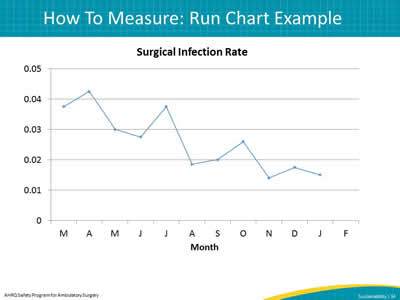
Say:
This figure shows an example of a run chart to measure SSI rates within your facility. Tracking and displaying the run chart for your team allows for progress tracking and transparency of data. Not only can the staff see the month-to-month progress with this type of measurement chart, but also when the measures have crossed your facility’s Threshold for Alarm, triggering an immediate response. A run chart tracks fluctuations within the measurement instead of a simple increase or decrease.
Slide 35: How To Measure: Small Multiples Example
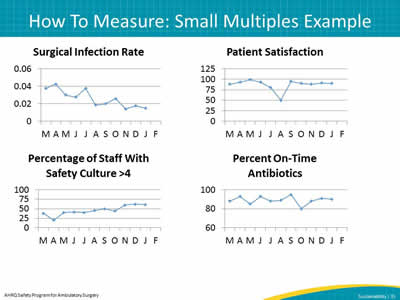
Say:
In this example, the figures show the team the impact of their changes on the entire system, facility, or unit instead of just looking at one measure at a time. The surgical safety team’s family of measures shows improvement in antibiotic use and safety culture and most importantly in the rate of surgical site infections. This has been achieved without any decrease in satisfaction or increase in cost (balancing measures). Because these measures are displayed over time, assessing whether the process changes are being sustained over time is possible.
Slide 36: Establish Followup and Feedback System
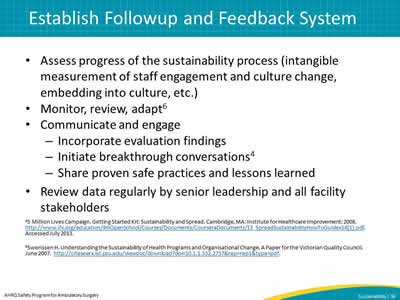
Say:
Establishing robust and transparent data feedback systems is important in monitoring process and outcome measures for improvements. To do this, ensure regular collection and reporting of performance data in addition to publically displaying data on all improvement interventions.
Examples of feedback include—
- Reports from those involved in the improvement process at the facilities.
- Communication between experienced improvement professionals within the organization and staff who are new to the implementation process
- Using data to assess the progress of sustainability and modifying organizational responsibility to succeed with the improvement goals.
Slide 37: Sustainability Examples: Organizational Structure
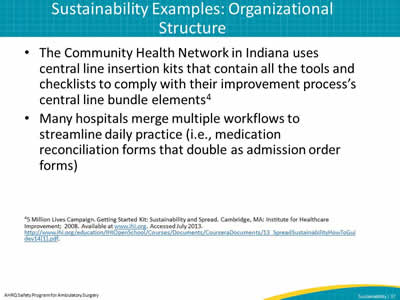
Say:
Learning from successful examples of sustainability across multiple settings shows how projects can be sustained in different environments. The following examples will provide “lessons learned” to assist in sustainability in your facility.
An example of project sustainment in a hospital system, utilizing organizational structure, is at the Community Health Network in Indianapolis, which uses central line insertion kits that contain all the tools and checklists to comply with their improvement process’s central line bundle elements. In addition to this efficiency improvement, many hospitals merge multiple workflows to streamline daily practice (i.e., medication reconciliation forms that double as admission order forms).
Ask:
In what ways does your facility sustain improvements? What strategies could your facility use to sustain improvements moving forward?
Slide 38: Sustainability Examples: Data
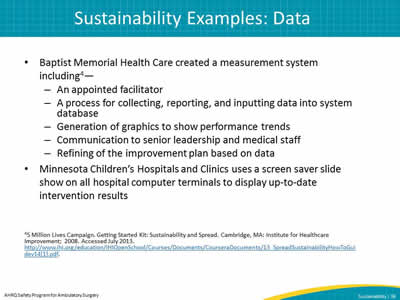
Say:
Another example of project sustainment in a health care system focuses on data and feedback.
Baptist Memorial Health Care System created a measurement system including an appointed facilitator, a process for collecting and reporting data and inputting data into a system database, generation of graphics to show performance trends, and feedback and communication to senior leadership and medical staff. Most importantly, they use this data to refine their improvement plan.
Another example of using data to sustain improvements is at Minnesota Children’s Hospitals and Clinics, which use a screen saver slide show on all hospital computer terminals to display up-to-date intervention results. This encourages participation and communication in improvement projects while motivating staff.
Ask:
In what ways does your facility sustain improvements? What strategies could your facility use to sustain improvements moving forward?
Slide 39: Sustainability Examples: Capacity Building
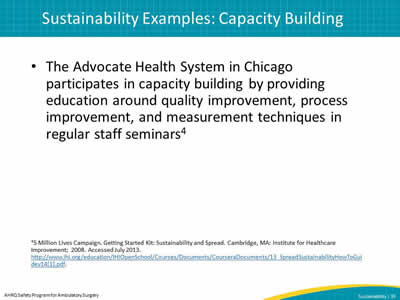
Say:
Building capacity is important to sustain improvements by having continuous education and staff training. The Advocate Health System in Chicago participates in capacity building by providing education around quality improvement, process improvement, and measurement techniques in regular staff seminars.
Ask:
In what ways does your facility sustain improvements? What strategies could your facility use to sustain improvements moving forward?
Slide 40: Summary
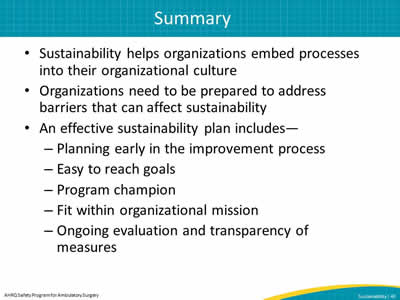
Say:
In summary, sustainability can help organizations embed processes into their organizational culture, making improvement the norm. Organizations need to address external and internal factors that can benefit or impede sustainability. An effective sustainability plan involves planning early in the improvement process, choosing easy to reach goals that are attainable, identifying a strong program champion to rally around the improvement, choosing a focus that fits with the organizational mission, and ongoing evaluation and transparency of process and outcome measures.
Slide 41: Tools
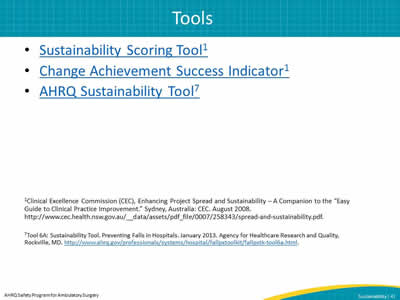
Say:
Tools can assist in supporting the sustained implementation of an intervention at many points of the process. Some helpful tools include—
Sustainability Scoring Tool1
This scoring tool is based on the sustainability module created by the United Kingdom’s National Health Service Institute for Innovation and Improvement. The tool can be used to assess the likelihood of sustainability and determine key improvement areas.
Change Achievement Success Indicator Tool1
Similar to the sustainability scoring tool, the Change Achievement Success Indicator Tool assesses whether an organization has taken the necessary steps to carry out a change successfully and sustainably.
AHRQ Sustainability Tool7
The AHRQ Sustainability Tool can be used to identify sustainability issues in planning and implementing your improvement and prevention efforts. While this tool focuses on fall prevention, it can be modified to your facility’s improvement process as needed.
Run Charts
Access an overview and database to help create your own run chart: http://www.ihi.org/knowledge/Pages/Tools/RunChart.aspx
Slide 42: References
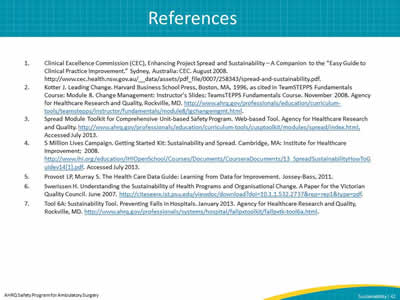
- Clinical Excellence Commission (CEC), Enhancing Project Spread and Sustainability – A Companion to the "Easy Guide to Clinical Practice Improvement." Sydney, Australia: CEC. August 2008. http://www.cec.health.nsw.gov.au/__data/assets/pdf_file/0007/258343/spread-and-sustainability.pdf.
- Kotter J. Leading Change. Harvard Business School Press, Boston, MA, 1996, as cited in TeamSTEPPS Fundamentals Course: Module 8. Change Management: Instructor's Slides: TeamsTEPPS Fundamentals Course. November 2008. Agency for Healthcare Research and Quality, Rockville, MD.
- Spread Module Toolkit for Comprehensive Unit-based Safety Program. Web-based Tool. Agency for Healthcare Research and Quality. Accessed July 2013.
- 5 Million Lives Campaign. Getting Started Kit: Sustainability and Spread. Cambridge, MA: Institute for Healthcare Improvement; 2008. Accessed July 2013.
- Provost LP, Murray S. The Health Care Data Guide: Learning from Data for Improvement. Jossey-Bass, 2011.
- Swerissen H. Understanding the Sustainability of Health Programs and Organisational Change. A Paper for the Victorian Quality Council. June 2007.
- Tool 6A: Sustainability Tool. Preventing Falls in Hospitals. January 2013. Agency for Healthcare Research and Quality, Rockville, MD.



